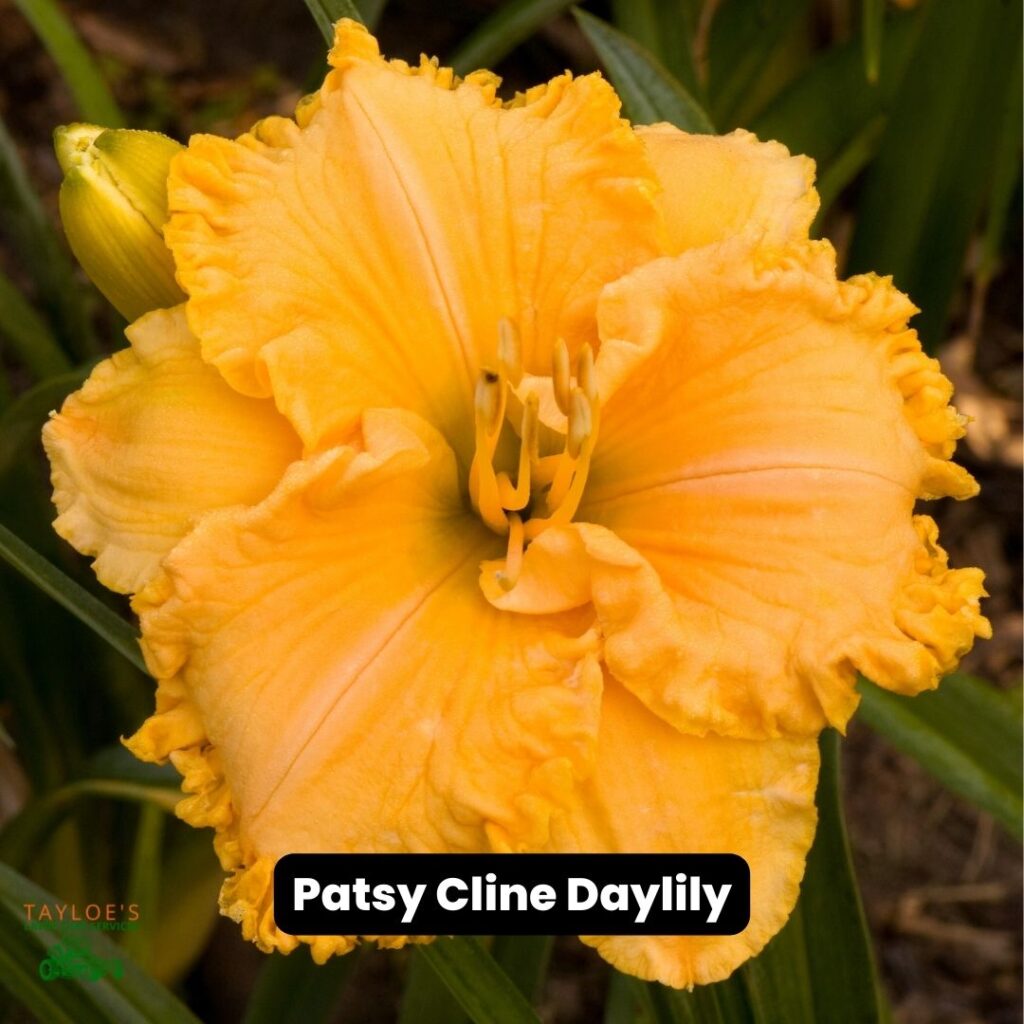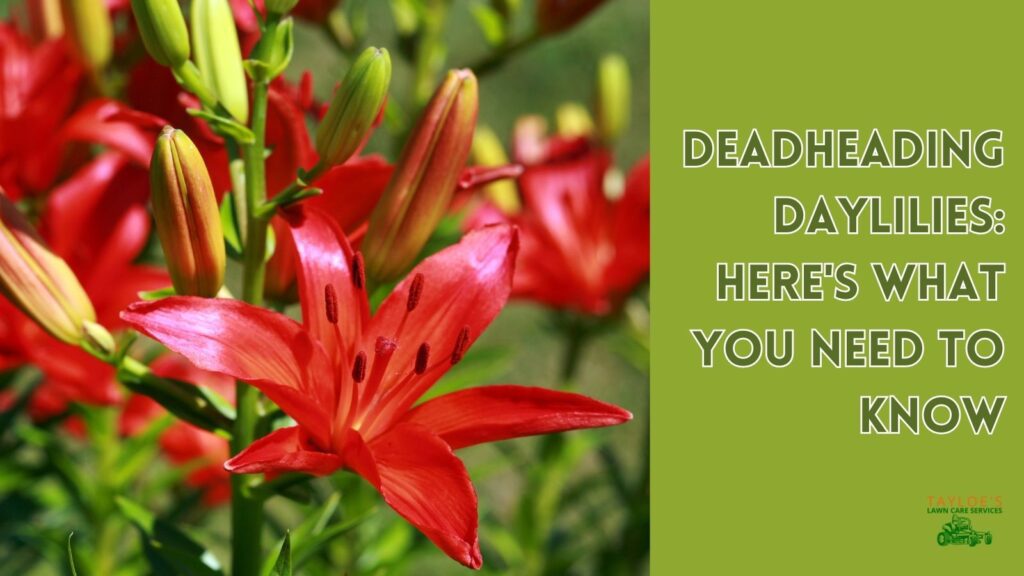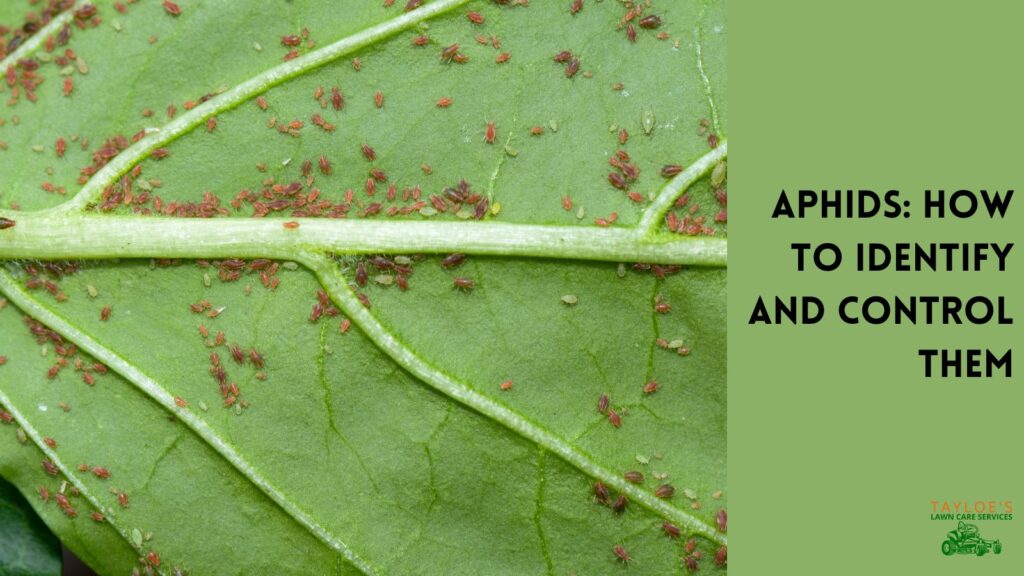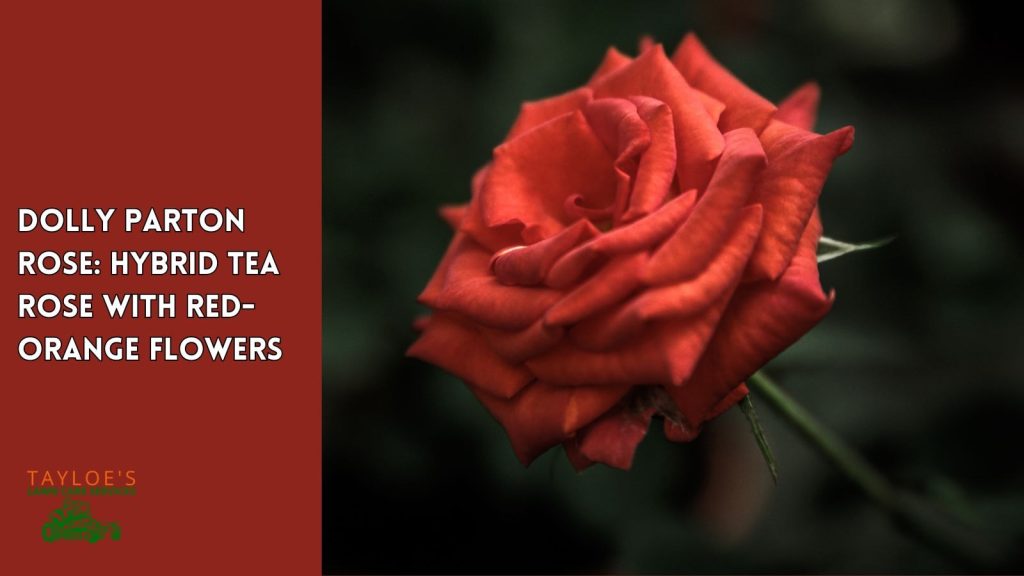Last Updated on: 17th February 2025, 05:49 am

Have you ever heard of the Patsy Cline daylily?
Everyone knows I am crazy for two things: Patsy Cline’s music (and old country music in general) and daylilies. So, most are not surprised that I have a particular fondness for the Hemerocallis ‘Patsy Cline’ daylily, Latin – Hemerocallis ‘Patsy Cline.’
Daylilies, belonging to the genus Hemerocallis, are famous for their vibrant blooms and ease of care, a favorite among gardeners and horticulturists. The Hemerocallis’ Patsy Cline’ is a particularly striking specimen among the myriad of daylily varieties. The ‘Patsy Cline’ daylily has some of the most stunning flowers.
The blossoms of this daylily cultivar showcase a remarkable blend of orange flowers with a ruffled edge and cream midrib. Named in honor of the legendary country music singer Patsy Cline, this variety embodies a sense of vibrancy and resilience reminiscent of its namesake’s spirit.
By the end of this article, you will be better able to determine whether you should add this flower to your landscape plan.
Quick Facts About the Patsy Cline Daylily
Golden peach to orange with cream midribs
Slightly trumpet-shaped flowers with a ruffled edge.
Grows in USDA zones 3 through 9
Reblooming daylily: Blooms in the early to mid-season and again at the end of summer
Loves the full sunshine
Semi-evergreen perennial
Hybrid, registered in 2008
Flowers grow up to 7″ across
Full plant height up to 36″
18 to 24″ spread
Five branches, producing up to 40 buds per plant
Historical Background of Hemerocallis Patsy Cline
The Hemerocallis’ Patsy Cline’ daylily comes from the dedicated efforts of hybridizers who sought to create a plant as remarkable as its namesake. The ‘Patsy Cline,’ a product of meticulous cross-breeding techniques aimed at enhancing specific floral characteristics, was bred in the United States. This variety emerged from a lineage of Hemerocallis species, each contributing unique traits that culminated in the creation of the ‘Patsy Cline.’
They wanted to pay tribute the iconic American country music singer known for her rich, expressive voice and emotionally resonant songs. Similarly, the ‘Patsy Cline daylily has striking blooms and graceful form. The naming is a tribute and a reflection of the plant’s standout qualities – resilience, beauty, and an ability to captivate audiences.
The creation of this daily variety marks a significant achievement in this ongoing pursuit. It offers a visually stunning plant and is relatively easy to care for, making it a desirable addition to gardens across different climates and settings.
Its emergence as a popular cultivar underscores the endless possibilities inherent in horticultural science, where patience, skill, and creativity come together to create living works of art.
Botanical Description of Modern Cultivars of Daylily Flowers
The Hemerocallis’ Patsy Cline’ daylily is a botanical marvel characterized by its distinctive and enchanting floral attributes. Each bloom of the ‘Patsy Cline’ presents a harmonious blend of colors, typically featuring a vivid palette that may include shades of rich yellow or soft peach, but generally a lush orange with cream midribs. The combination of orange with ruffled edge and cream midribs sets it apart in any garden setting, drawing the eye with its radiant display.
The flowers are generous in size, as grand as seven inches wide. Each petal unfurls to reveal a gracefully ruffled edge, contributing to a lovely textural appeal. The blooms are borne on five sturdy scapes that rise above the foliage, creating a dramatic display when the plant is in full bloom.
In terms of foliage, the ‘Patsy Cline’ daylily has long, arching leaves that form a dense clump. The leaves are typically bright green, providing a lush backdrop for the spectacular blooms. The semi-evergreen foliage remains attractive throughout the growing season, with the appearance of ornamental grasses.
This variety typically reaches almost three feet tall, making it suitable for various garden placements. The plant’s growth habit is clump-forming, allowing it to grow gradually each year. The cultivar is hardy and adaptable, capable of thriving in dry-ish garden conditions, though it prefers well-drained soil and ample sunlight to achieve peak blossoming.
Darylily flowers have a relatively short blooming period—each lasts just one day—a characteristic trait of the Hemerocallis genus. However, due to the high bud count, the overall blooming period extends over several weeks, providing long-lasting, showy flowers in the garden.
The Hemerocallis’ Patsy Cline’ is typical of the beauty and diversity of daylilies. Its striking appearance and robust nature make it a wonderful addition to any garden, exemplifying the ideal qualities that make daylilies a perennial favorite among gardeners and plant admirers.
Cultivation and Care of the Patsy Cline Daylily
Growing the hemerocallis’ Patsy Cline’ daylily is a rewarding experience for gardeners, given its relative ease of care. This variety thrives under specific conditions and responds well to basic gardening practices.
Ideal Growing Conditions:
Sunlight: ‘Patsy Cline’ daylilies perform best in full sun to partial shade. At least six hours of direct sunlight daily is ideal for optimal blooming. It won’t mind a bit of shade during the hottest part of the afternoon.
Soil: They prefer well-drained soil. While adaptable to various soil types, a slightly acidic to neutral pH is beneficial.
Water: Regular watering is essential, especially during the growing and blooming season. The soil should be kept evenly moist but not soggy. However, it is also relatively drought-tolerant and will survive dry spells while blooming less prolifically.
Planting Guidelines:
Plant in spring or early fall to establish roots before extreme summer heat or winter cold.
Space plants about 18 to 24 inches apart to ensure adequate room for growth.
Plant the crown (the part where roots meet the stem) about one inch below the soil surface.
Maintenance Tips:
Fertilizing: Apply a balanced, slow-release fertilizer in early spring and again in mid-summer to promote healthy growth and vibrant blooms.
Pruning: Deadhead spent blooms regularly to encourage more flowers. Cut back the foliage before new growth begins in late fall or early spring.
Division: Every two to three years, divide the clumps in early spring or after flowering to rejuvenate the plant and maintain vigor.
Pest and Disease Management:
Keep an eye out for common pests like aphids and slugs. Treat infestations promptly with appropriate measures.
Watch for signs of disease, such as leaf streaks or rust, and apply fungicides if necessary.
Winter Care:
In colder climates, a layer of mulch can help protect the roots from freezing temperatures.
The ‘Patsy Cline’ day lily is a robust and forgiving plant, making it suitable for gardeners of various skill levels. By following these cultivation and care guidelines, you can ensure that Hemerocallis’ Patsy Cline’ remains a vibrant and enchanting feature in the garden year after year.

Landscape Uses
The Hemerocallis’ Patsy Cline’ daylily is a horticultural delight and a versatile landscape design player. Its vibrant blooms and lush foliage make it an excellent choice for most garden settings and styles.
Incorporating ‘Patsy Cline’ Daylily into Garden Designs:
Border Plantings: The ‘Patsy Cline’ is ideal for borders along walkways or garden edges. Its moderate height and clumping growth habit create an appealing, organized look.
Mass Plantings: Planting these daylilies in large groups can create a stunning sea of color, which is especially effective in larger garden spaces.
Mixed Flower Beds: Pair ‘Patsy Cline’ with other perennials and annuals for a diverse and dynamic display. Its flowers can complement a variety of other plant forms and colors.
What Daylilies Grow Well With (Companion Plants):
Combine with sun-loving perennials like coneflowers, black-eyed Susans, and lavender for a vibrant, textured display.
Grasses and ferns can provide a contrasting backdrop to the bold blooms of the ‘Patsy Cline.’
Spring bulbs planted in the same area can offer early color before the daylilies bloom.
Garden Styles:
Cottage Gardens: ‘Patsy Cline’ fits perfectly into the informal, densely planted style of cottage gardens. They make fantastic cut flowers.
Modern Landscapes: Use in minimalist designs for a pop of color against a more neutral backdrop.
Pollinator Gardens: The flowers attract butterflies and bees, making them an excellent choice for gardens that support wildlife.
Container Gardens: Suitable for container gardening.
Drought-tolerant Landscaping:
Once established, the plant’s drought tolerance makes it suitable for xeriscaping or low-water gardens.
Its non-invasive nature makes it less likely than other daylilies to overrun other plants in shared beds.
Incorporating Hemerocallis’ Patsy Cline’ into a garden brings aesthetic appeal and an opportunity for creative expression. By understanding its characteristics and considering its companions and placement, gardeners can enhance their outdoor spaces’ visual impact and enjoyment.
Pest and Disease Management for the Hemerocallis Patsy Cline Daylily
While robust and resilient, the Hemerocallis ‘Patsy Cline’ is not immune to pests and diseases. Effective management strategies are essential to maintain the health and beauty of these plants. Here’s how gardeners can tackle common issues:
Common Pests:
Aphids and Thrips: These tiny insects can suck sap from the leaves and flowers, weakening the plant. They can be controlled with insecticidal soaps or neem oil.
Slugs and Snails: These pests are particularly fond of tender leaves and can be managed with slug baits or diatomaceous earth.
Disease Prevention and Treatment:
Rust and Leaf Streak: These fungal diseases cause discoloration and damage to the foliage. Preventative measures include ensuring good air circulation and avoiding overhead watering.
Crown Rot: This is caused by soil-borne fungi and can be prevented by ensuring good drainage and avoiding overwatering. Infected plants should be removed and destroyed.
Cultural Practices:
Keeping the area around the plants clean and debris-free can help prevent the onset of pests and diseases.
Regular inspection of plants allows for early detection and more effective treatment of problems.
Healthy Plant Practices:
Strong, healthy plants are less susceptible to pests and diseases. Proper fertilization, watering, and pruning can significantly reduce the likelihood of issues.
By understanding and implementing these pest and disease management strategies, gardeners can ensure that their Hemerocallis ‘Patsy Cline’ daylilies remain healthy and vibrant, showcasing their full beauty throughout the growing season.

The Takeaway: Patsy Cline Daylily Is Worth Your Consideration
The Hemerocallis ‘Patsy Cline’ daylily is a true beauty that will be versatile in any sunny nook of your garden. Whether you admire its striking blooms or drought tolerance, the ‘Patsy Cline’ daylily will make a remarkable and resilient perennial for your garden beds.
If you enjoy having a beautiful lawn and garden, call or text Tayloe’s Lawn Care Services at 252.287.3376. We provide lawn care service in Windsor, NC, and all of Bertie County Murfreesboro and Ahoskie in Hertford County. Or, if you enjoy reading gardening and landscaping content, like this article about Hemerocallis ‘Patsy Cline’ Daylily, be sure to follow us on Facebook – we share regularly.
Author Profile

- Deborah Tayloe is the CEO and co-founder of Tayloe's Lawn Care Services, LLC. She has a B.S.Ed and holds certificates in soil and water management and herbology from accredited programs.
Latest entries
 GardeningSeptember 27, 2025What perennials, shrubs, and trees don’t like fall pruning (and why)?
GardeningSeptember 27, 2025What perennials, shrubs, and trees don’t like fall pruning (and why)? Trees and ShrubsSeptember 14, 2025Fall Shrub Pruning Guide (September–October)
Trees and ShrubsSeptember 14, 2025Fall Shrub Pruning Guide (September–October) Trees and ShrubsApril 22, 2025Boxwood Blight: Early identification and isolation
Trees and ShrubsApril 22, 2025Boxwood Blight: Early identification and isolation Flower GardenApril 8, 2025John F. Kennedy Rose: Hybrid tea rose with elegant white blooms
Flower GardenApril 8, 2025John F. Kennedy Rose: Hybrid tea rose with elegant white blooms







